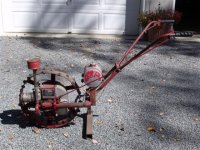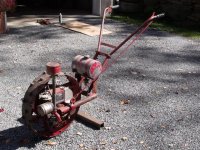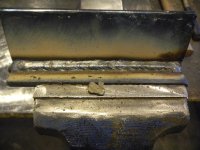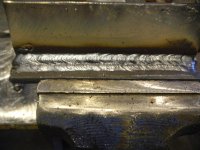I have to power this off a 6500 watt gen with a 220 port, that puts out 27 amps
You should do your research before you buy to make sure that the welder will run successfully off a generator. I don't know the details, but some welders say they're not rated for generators unless the generator puts out "clean" power. Also, the current draw when you strike the arc can be much higher than when the machine is running. If the generator is not able to keep up, the voltage will drop, and you will find it very hard to strike the arc. In other words, your generator may be rated for 27 amps, but you may still find it hard to strike an arc at max output of a welder drawing close to 27 amps. You should consult with a pro like Mark at Everlast or Simon at Longevity to confirm that whatever you want to buy will run acceptably on your generator.
I had originally planned to run my welder off my generator, but after looking at all the complications, and especially after considering I'd end up spending around $100 on a pigtail to convert my generator's twist-lock receptacle to my welder's 6-50 plug, I just ended up putting in a 220v receptacle near my service panel. If you have two spare breaker spots in your service panel, it's not too hard. I realize that this may not be an option for everybody, such as renters, but I would give it a second look if possible.
so I don't think going over a 160 size is going to work for me.
My only objection to that unit is that it's made in China. Problem is the smaller Hobarts are too
if I'm not mistaken, you can't depend upon country of origin.
This is a common objection. Many "USA-made" names are actually made in China and assembled in America. And even if they are technically "made in America," they are often made from Chinese parts. There is no question that a Chinese-made product can be as good or as bad as the manufacturer is willing to pay to make it.
But the bottom line is the product is either built well or not, no matter where it's built.
It's all in the spec, the quality of mfg and quality control.
But if this unit costs say 450 and the same capability US made one costs a hundred bucks more,
I'll pay it. Problem is the cost is usually a lot more.
Right. The equivalent US models are often 2x the price of an Everlast or Longevity. My impression is that if the Chinese model doesn't fail within the first 10-20 hours, it's probably going to last as long as anything else. So really put some heat on it during the first 30 days and then relax.
The other thing is that I know Mark is a regular here at TBN, and I know he values his reputation, so even if I had a little hesitation about buying Chinese (which I don't, but if I did), knowing that Mark has done right by others here would reassure me some. I wouldn't consider myself to be buying from Everlast; I'd be buying from Mark.
I've ruled out buying used, even something allegedly "such a deal" like this:
Lincoln Electric Arc Welder Brand New for Sale / Trade
for all I know it came out of a flooded basement. Or shall we say was never paid for...
So, going to buy new this time.
I wouldn't hesitate to buy a transformer-based welder used. Those things are tanks; there is just not much in there to go wrong. If it strikes and holds an arc, it's probably about as good as the day it was sold. With a DC welder, the diodes can fail, which you can quickly determine by trying to strike an arc and weld with it. You'll know in a heartbeat. Of course, if you never welded before, you may want to bring a friend who can strike an arc. Open the case up and look to see if it's full of corrosion or scorch marks. If it's dusty-or-better, you're probably good to go. There are lots and lots of those old machines sitting in attics, garages, and barns, that will sell for $100-$150 all day long, and will serve somebody until their dying day. That being said, I definitely understand the appeal of buying new, and you can get a lot of whiz-bang features, like hot start and arc force control, in the inverter-based machines.



